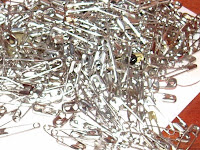 In my last post, I wrote about my antique tobacco box, which I use to store safety pins. Hundreds and hundreds of safety pins. My dry cleaners uses three for every article of clothing -- two to attach it to the hanger, and one to attach the tag. I don't like to waste perfectly good things, so I dutifully keep all of them.
In my last post, I wrote about my antique tobacco box, which I use to store safety pins. Hundreds and hundreds of safety pins. My dry cleaners uses three for every article of clothing -- two to attach it to the hanger, and one to attach the tag. I don't like to waste perfectly good things, so I dutifully keep all of them.Maybe I could return them every few months, like the wire hangers? Or maybe I could donate them somewhere. A colleague from a former job used to make cool bracelets out of pins. Like this one I found on the internet:

Thinking abou
 t pins made me realize how much we take for granted these seemingly simple, everyday objects. I got to wondering about the history of this handy little tool, so I did some research.
t pins made me realize how much we take for granted these seemingly simple, everyday objects. I got to wondering about the history of this handy little tool, so I did some research.A New Yorker named Walter Hunt is credited with the invention of the safety pin, which he apparently invented in a couple of hours in 1849 to pay off a $15 debt. He sold the patent, #6281, for $400. Just in case you are dying to see it, here is his original patent, courtesy of the U.S. Patent Office:


But safety pins date back at least to ancient Greece. According t
 o The Big Site of Amazing Facts, "Homer tells us that a dozen safety pins were presented to Penelope, the wife of Odysseus by her suitors, suggesting that the Greeks considered pins fitting gifts, even for royalty. Presumably, almost all early Greeks used safety pins to fasten their tunics, since the button wasn’t to arrive from Asia Minor until considerably later."
o The Big Site of Amazing Facts, "Homer tells us that a dozen safety pins were presented to Penelope, the wife of Odysseus by her suitors, suggesting that the Greeks considered pins fitting gifts, even for royalty. Presumably, almost all early Greeks used safety pins to fasten their tunics, since the button wasn’t to arrive from Asia Minor until considerably later."This site which also explains the history of the term "pin money":
"But for centuries, metal pins remained rare and costly items reserved for the rich....When the term originated in the fourteenth century, “pin money” was just that, for at the time, pins were expensive enough to be real items in the budget. By custom, a husband would present his wife on the first or second of January with enough money to buy her pins for the year. “Pin money” went by the boards in the nineteenth century, when mass-production made pins the inexpensive purchase they are today."
So there you have it. Everything you never wanted to know about saftey pins! Read more!






